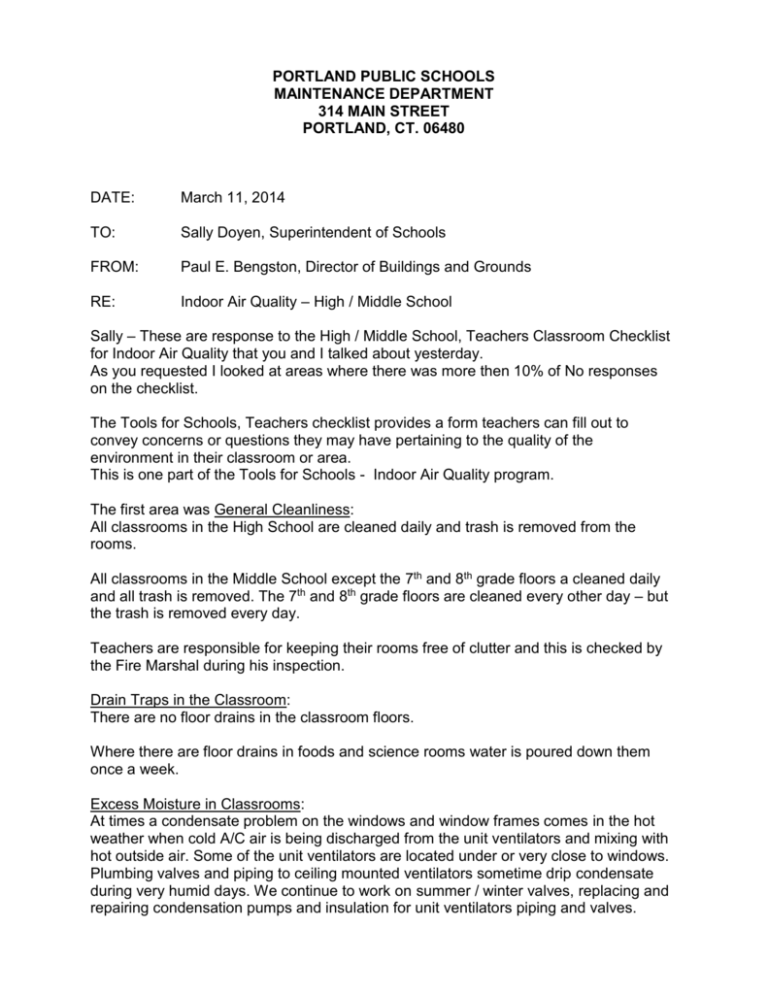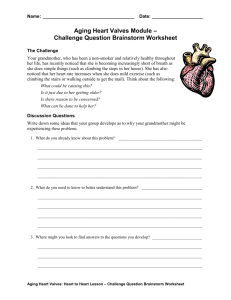Indoor Air Quality – High / Middle School
advertisement

PORTLAND PUBLIC SCHOOLS MAINTENANCE DEPARTMENT 314 MAIN STREET PORTLAND, CT. 06480 DATE: March 11, 2014 TO: Sally Doyen, Superintendent of Schools FROM: Paul E. Bengston, Director of Buildings and Grounds RE: Indoor Air Quality – High / Middle School Sally – These are response to the High / Middle School, Teachers Classroom Checklist for Indoor Air Quality that you and I talked about yesterday. As you requested I looked at areas where there was more then 10% of No responses on the checklist. The Tools for Schools, Teachers checklist provides a form teachers can fill out to convey concerns or questions they may have pertaining to the quality of the environment in their classroom or area. This is one part of the Tools for Schools - Indoor Air Quality program. The first area was General Cleanliness: All classrooms in the High School are cleaned daily and trash is removed from the rooms. All classrooms in the Middle School except the 7th and 8th grade floors a cleaned daily and all trash is removed. The 7th and 8th grade floors are cleaned every other day – but the trash is removed every day. Teachers are responsible for keeping their rooms free of clutter and this is checked by the Fire Marshal during his inspection. Drain Traps in the Classroom: There are no floor drains in the classroom floors. Where there are floor drains in foods and science rooms water is poured down them once a week. Excess Moisture in Classrooms: At times a condensate problem on the windows and window frames comes in the hot weather when cold A/C air is being discharged from the unit ventilators and mixing with hot outside air. Some of the unit ventilators are located under or very close to windows. Plumbing valves and piping to ceiling mounted ventilators sometime drip condensate during very humid days. We continue to work on summer / winter valves, replacing and repairing condensation pumps and insulation for unit ventilators piping and valves. Thermal Comfort: The High / Middle School was designed and built to the 2000 Building Code. It was designed so that each space be it a classroom, gym, office, library, etc. could have its own temperature controlled individuality by a main computer. This is done by large gas fired roof top units for large areas and hot or cold unit ventilators in classroom and some office areas. The roof top and wall units are also designed to bring in code required fresh air changes into spaces as much as three times a hour, at times causing teachers to complain of rooms being cool or cold and changing humidity in classroom and other areas. Ventilation: Ventilation is provided by the roof top and wall unit ventilators, windows and roof top exhaust fans. To check for signs of mold or mildew all roof top and wall unit ventilators filters are change at least two times a year, wall units are also vacuumed when filters are changed. See attached: High School filter information. Educational Supplies: Minimized exposure to hazardous material; all custodial supplies used in everyday cleaning are listed as Green Cleaning products. MSDS - Material Safety Data Sheets, are kept on file at each schools head custodian’s office and the Maintenance Department Office. All floor stripper and finish used in all schools are Green certified products. All spray bottles are labeled with proper labels provided by the manufacture. A letter from the Superintendent has been sent to all staff advising them to not bring any cleaning products from home and to use only products provided by the school custodial staff. Local Exhaust Fans: All spaces in the High / Middle School are properly exhaust vented by roof top exhaust fan system as required by code. All roof top exhaust units are checked by the maintenance department and vendors servicing the equipment. In some cases the maintenance department has extended the exhaust ducts to be sure they are venting over the roof in that area. Note: At a point during the renovation construction project the new heating / cooling system was tied into the high school’s old heating system. A short time after the tie in was done we started having problems with a fine sediment clogging and jamming up the small control valves in the heating and cooling units. During the project all these small valves were changed out at the cost to the contractor and Honeywell. After the project was completed all valves were again changed out. Some time after the change out was done the valves started to not operate correctly again causing heating or cooling problems in the classrooms, thus causing teachers issues with classroom temperatures and at times moisture problems. About a year ago I complained to the contractor that did the control work and I received another complete set of replacement valves. At this time we have changed out all the valves that have caused problems and continue to do so when we have a valve problem. After talking to several engineers it became apparent that a good filtration system was needed to help correct the sediment problem. After talking to Sally about the problem, she said to look into a filter system. We have completed the first step of getting a filter system that would filter glycol and remove sediment. This involved a contractor to do all the heavy plumbing work – cutting and welding the 6” steel pipe to provide drops that will allow us to install a filtration system. At this time we are in the final process of looking at filter system that will provide the needed filtration, comply with environmental code of filtering glycol and will handle condensate when filtering chilled coolant. After the new filtration system is installed and the system is completely flushed and filtered several times we should not have any more problems with stuck valves in the unit ventilators in the classrooms.







